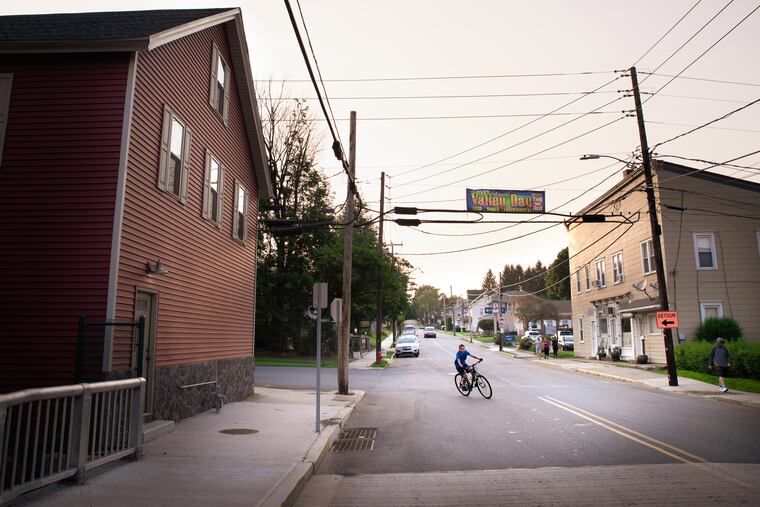In defense of hometowns | Opinion
Should we celebrate, rather than lament, when people stay to rejuvenate their small towns rather than leave for the big city?

Before Henry Ford introduced the Model T in 1908, the average American stayed within 12 miles of home. Even when automobiles became cheaper and better roads improved travel, leaving town for leisure or work merited an item in the local newspaper. As the economy expanded, people traveled farther and moved elsewhere, pursuing aspirations beyond rural towns.
Today, though, the United States is seeing record lows in mobility. Though the information revolution eliminated communication barriers, an evolving economy appears to have slowed the rate at which Americans change their geographic residences: They’re moving at the lowest rate since 1948, when the Census Bureau began tracking mobility. The trend is not new, however. As economists from the Federal Reserve and the University of Notre Dame observed in 2011: “Internal migration has fallen noticeably since the 1980s, reversing increases from earlier in the century.”
A recent study from the Federal Reserve Bank of New York considers the reasons for this “migration aversion.” Released in April, it reviews the bank’s data to investigate individuals’ willingness to leave their current location. The authors find that people confront significant psychological costs in leaving behind family ties and forgoing shared cultural norms. These costs “all increase with age and residency tenure,” they note, and “are remarkably large for a non-trivial fraction of the population.” The biggest factor in limited mobility, the study finds, is a yearning for rootedness, regardless of economic status: “The median person in our sample will forgo 30 percent of his or her income in order to stay close to family.”
The authors worry about the implications of less migration. An unwillingness to move, they argue, especially “among lower skilled workers . . . is likely contributing to reduced economic mobility, increased inequality, political polarization, and the growing urban-rural divide.”
Researchers and pundits often lament that some Americans choose to remain in struggling communities. But a packed U-Haul and a new locale can engender loneliness and disorientation, not emotional renewal or economic relief. Perhaps unintentionally, the Fed study might encourage a renewed appreciation for hometown attachments. Many heartland communities, for instance, are dealing with decline but remain stable. Should more residents just pack up and leave?
» READ MORE: 10 years after immigration disputes, Hazleton is a different place
For a time, I lived in northeastern Pennsylvania’s Greater Hazleton region, where I learned firsthand, as the authors write, “the important amplifying roles played by family, friends, and shared norms and values in the decline of residential mobility rates.” Though I grew up in Hershey, I’ve always considered Hazleton a second home. My forebears settled in the area in the 1840s, and my parents were raised there. Regular family visits with my paternal grandmother, who lived on the city’s South Side, fostered an enduring appreciation for regional posterity.
Geology dictated Hazleton’s growth. Its anthracite mines fueled the development of a mountaintop city, where a shared culture fostered community pride, ethnic traditions, religious devotion, reciprocity, and a deep understanding of ancestral struggle. The predominantly Catholic city and its surrounding towns contrasted with the nearby Conyngham Valley, where the absence of coal preserved a bucolic agricultural setting. When the mines closed and interstate highways opened, scores of families moved into this valley.
After securing an employment opportunity in Hazleton, I moved to Conyngham borough, my mother’s hometown, a picturesque bedroom community at the foot of the Spring Mountain. During my time there, I developed an even deeper appreciation for rootedness. When the region’s volatile weather permitted, I’d take evening walks on the town’s Rockwellian, tree-lined main street and admire the homes and bungalows, say hello to fellow walkers or older couples sitting on porches, explore the borough’s natural scenery, and frequent the Brass Buckle, its popular local restaurant.
Conyngham has become a cultural extension of Hazleton because of the city’s decline. In Hazleton, urban neighborhoods with prewar housing have slipped into pockets of disorder, violence, and blight. This downturn occurred quickly, forcing families to consider selling their multigenerational homes and leaving the city. For lifelong residents, memory constitutes an imperishable commodity. Many have stayed in their childhood neighborhoods, despite the city’s declining condition.
Numerous families, nonetheless, have elected to leave, moving outside the region or relocating to valley communities like Conyngham. In the valley, they work to preserve what they once possessed in Hazleton: a commanding knowledge of others’ family trees, a vast repository of local stories, and a celebration of inherited recipes and traditions. They stay because their valley remains what Hazleton once was — a safe, quiet enclave offering a middle-class life.
Should residents of Greater Hazleton follow the dismissive advice of many observers and just let their region die? “There’s also the question of happiness,” noted Brian Alexander in the Atlantic. “Maybe someone would make more money in some other city or town. But many people . . . love their town. Many are trying to rejuvenate it. Is that complacency, or positive civic duty?”
Places like Greater Hazleton unquestionably need help. Opportunity, prosperity, and a healthy quality of life should extend beyond the confines of cities’ costly urban rentals and metro suburbs’ exurban townhouses. Perhaps the real problem isn’t declining mobility, but that the social and economic conditions of so many communities — the result, in part, of policy choices — force residents to consider leaving, even when they might prefer to stay.
Charles F. McElwee is assistant editor of City Journal, where a version of this piece first appeared.